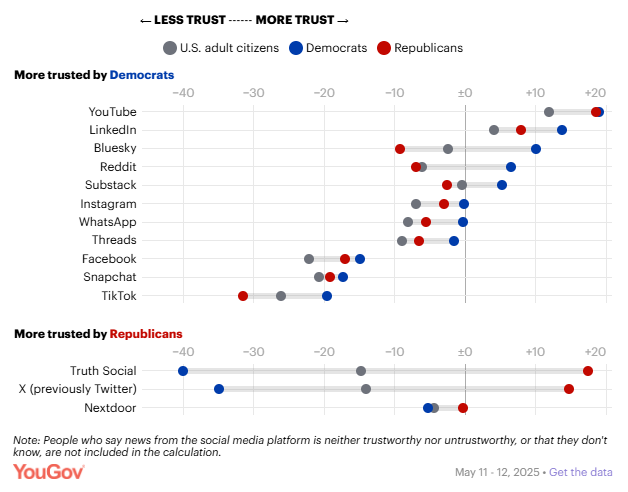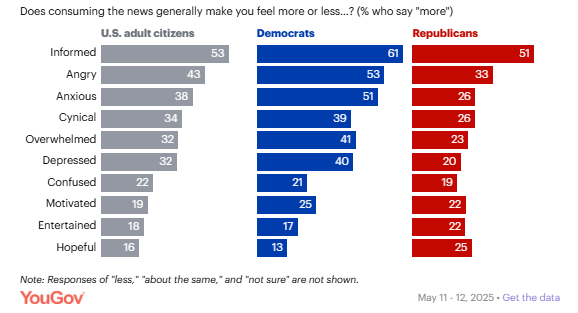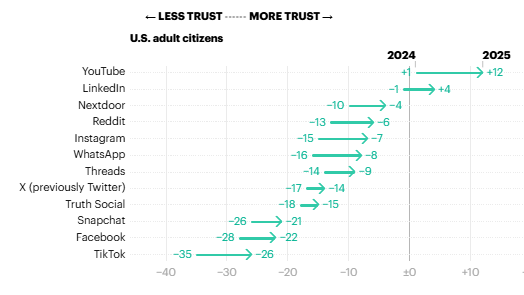Trust in Media: A Guide for Small Business Owners
In today’s world, navigating the media landscape can feel like walking through a minefield, especially for small and medium-sized businesses (SMBs) engaged with the U.S. government as service providers. With media sources that vary in trustworthiness and reliability, it’s crucial to know where to turn for accurate information. This blog aims to shed light on the current state of media trust among Americans, while also providing valuable resources that can support SMBs in leveraging government contracts and navigating the complexities of public perception.
The Polarized Media Landscape

The American news landscape is increasingly polarized, primarily along political lines. According to the latest YouGov poll conducted in 2025, there are stark differences in trust between Democrats and Republicans. Democrats tend to trust news sources more than Republicans do, with a significant gap in trust levels across various outlets. For instance, public broadcasters like the BBC and PBS are held in higher regard by Democrats, while Republicans lean towards outlets like Fox News and Newsmax.

Interestingly, the most trusted news source across the board is The Weather Channel, which maintains a net trust score that consistently places it at the top. In contrast, outlets like the National Enquirer are viewed with skepticism by both political sides. Brands like CNN and MSNBC are trusted more by Democrats, while Fox News enjoys the same status among Republicans. This divide makes it essential for SMBs to understand their audience’s media consumption habits when crafting their messages.
The Importance of Trustworthiness
Trust in media isn’t just about politics; it also affects how businesses communicate with their stakeholders. A recent survey found that about 53% of Americans feel informed by the news, yet many report feelings of anxiety and cynicism when consuming news. This emotional response can influence public perception of businesses, especially those involved in government contracts.
To better connect with your audience, consider the following:
1. Choose Your Channels Wisely: Align your messaging with media outlets that resonate with your target demographic. For example, if you are catering to a younger audience, platforms like YouTube and Instagram might be appropriate, whereas older audiences might respond better to traditional outlets like ABC or NBC.
2. Utilize Trusted Sources: Incorporate information from reputable sources in your communications. This not only enhances your credibility but also helps alleviate concerns about misinformation.

Resources for Small Business Owners
At Select GCR, we provide resources tailored for SMBs looking to thrive in the government contracting space. Here are a few pages from our site that can benefit you:
1. Government Programs – Learn how to leverage government programs for your business, including VOSB, SDVOSB, and HUBZone certifications.
2. Blog Insights – Our blog features tips and insights on navigating government contracting, with stories of successful SMBs.
3. Contract Support – Understand the support we offer for businesses seeking to secure government contracts and what benefits are available.
4. Resources for Small Businesses – Access a wealth of tools and articles designed to help small businesses grow and succeed in the government market.
5. Client Success Stories – Read about how other SMBs have successfully navigated government contracts and grown their businesses.
Understanding Media Consumption Trends
As a small business owner, understanding where your audience gets their news is crucial. The YouGov poll indicates that 61% of Americans turn to social media for news, while 60% rely on television. This trend is split across age demographics, with younger audiences preferring social media platforms and older audiences favoring traditional news channels. Knowing this can help you tailor your marketing strategies effectively.
You might find that utilizing social media for outreach can enhance your visibility and engagement with younger customers, while traditional media might be better suited for reaching older demographics. Platforms like LinkedIn and Facebook are often more trusted for business-related news, providing SMBs with an opportunity to connect with potential clients and partners in a professional space.
Building Trust in Your Brand
In a media landscape filled with skepticism, building trust is more critical than ever. Here are some strategies to enhance your business’s trustworthiness:
1. Transparency: Be open about your business practices and engage with your audience authentically. This includes sharing your successes and how you’ve navigated government contracts.
2. Engagement: Actively participate in discussions on social media and other platforms where your audience is present. This not only demonstrates your expertise but also shows that you value their input and perspectives.
3. Quality Content: Regularly share high-quality, informative content that addresses your audience’s needs. This could be in the form of blogs, white papers, or videos that provide valuable insights.
Conclusion
As an SMB involved in government contracting, understanding the dynamics of media trust is essential. By recognizing the polarized nature of the media landscape and employing strategies to enhance your business’s credibility, you can better position your brand for growth. Remember, trust takes time to build but can significantly impact your success in the government contracting space.
For further assistance in navigating government programs and enhancing your business’s credibility, visit us at Select GCR. We’re here to support you every step of the way.
Sources:
– YouGov Poll on Trust in Media (2025)
– Pew Research Center on Media Consumption Trends (2025)
– Select GCR Blog and Resources



